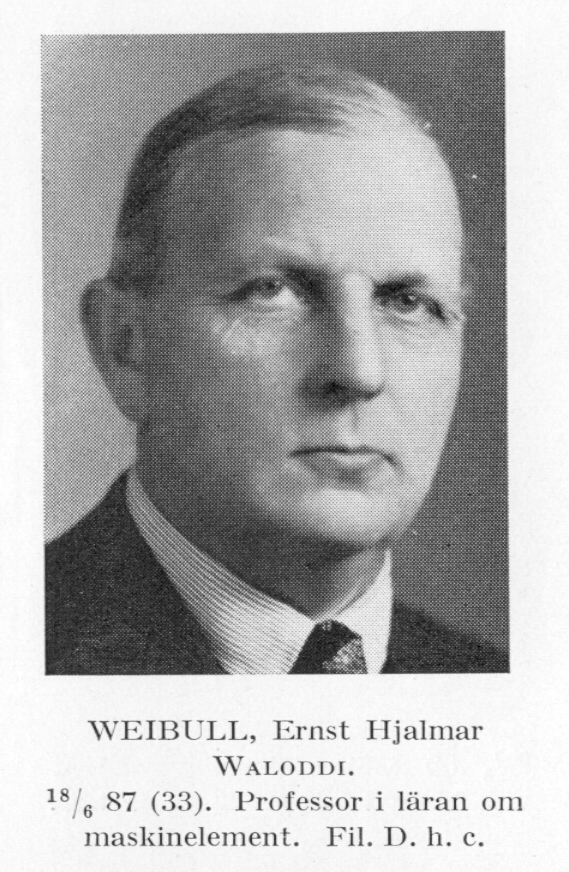|
Weibull Fading
Weibull fading, named after Waloddi Weibull, is a simple statistical model of fading used in wireless communications and based on the Weibull distribution In probability theory and statistics, the Weibull distribution is a continuous probability distribution. It is named after Swedish mathematician Waloddi Weibull, who described it in detail in 1951, although it was first identified by Maurice Re .... Empirical studies have shown it to be an effective model in both indoor and outdoor environments. In 2005, a theoretical model for a particular class of Weibull distributions was described by Sagias and Karagiannidis, who also analyzed channel capacity of a wireless channel in the presence of Weibull fading. References * Radio frequency propagation fading {{wireless-stub ... [...More Info...] [...Related Items...] OR: [Wikipedia] [Google] [Baidu] |
Waloddi Weibull
Ernst Hjalmar Waloddi Weibull (18 June 1887 – 12 October 1979) was a Swedish civil engineer, materials scientist, and applied mathematician. The Weibull distribution is named after him. Education and career Weibull joined the Swedish Coast Guard in 1905 as a midshipman. He moved up the ranks with promotion to sublieutenant in 1907, Captain in 1916 and Major in 1940. While in the coast guard he took courses at the Royal Institute of Technology. In 1924 he graduated and became a full professor. He obtained his doctorate from the University of Uppsala in 1932. He was employed in Swedish and German industry as a consulting engineer. In 1914, while on expeditions to the Mediterranean, the Caribbean and the Pacific Ocean on the research ship ''Albatross'', Weibull wrote his first paper on the propagation of explosive waves. He developed the technique of using explosive charges to determine the type of ocean bottom sediments and their thickness. The same technique is still used today ... [...More Info...] [...Related Items...] OR: [Wikipedia] [Google] [Baidu] |
Statistical
Statistics (from German: ''Statistik'', "description of a state, a country") is the discipline that concerns the collection, organization, analysis, interpretation, and presentation of data. In applying statistics to a scientific, industrial, or social problem, it is conventional to begin with a statistical population or a statistical model to be studied. Populations can be diverse groups of people or objects such as "all people living in a country" or "every atom composing a crystal". Statistics deals with every aspect of data, including the planning of data collection in terms of the design of surveys and experiments.Dodge, Y. (2006) ''The Oxford Dictionary of Statistical Terms'', Oxford University Press. When census data cannot be collected, statisticians collect data by developing specific experiment designs and survey samples. Representative sampling assures that inferences and conclusions can reasonably extend from the sample to the population as a whole. An experim ... [...More Info...] [...Related Items...] OR: [Wikipedia] [Google] [Baidu] |
Fading
In wireless communications, fading is variation of the attenuation of a signal with various variables. These variables include time, geographical position, and radio frequency. Fading is often modeled as a random process. A fading channel is a communication channel that experiences fading. In wireless systems, fading may either be due to multipath propagation, referred to as multipath-induced fading, weather (particularly rain), or shadowing from obstacles affecting the wave propagation, sometimes referred to as shadow fading. Key concepts The presence of reflectors in the environment surrounding a transmitter and receiver create multiple paths that a transmitted signal can traverse. As a result, the receiver sees the superposition of multiple copies of the transmitted signal, each traversing a different path. Each signal copy will experience differences in attenuation, delay and phase shift while traveling from the source to the receiver. This can result in either construc ... [...More Info...] [...Related Items...] OR: [Wikipedia] [Google] [Baidu] |
Wireless
Wireless communication (or just wireless, when the context allows) is the transfer of information between two or more points without the use of an electrical conductor, optical fiber or other continuous guided medium for the transfer. The most common wireless technologies use radio waves. With radio waves, intended distances can be short, such as a few meters for Bluetooth or as far as millions of kilometers for deep-space radio communications. It encompasses various types of fixed, mobile, and portable applications, including two-way radios, cellular telephones, personal digital assistants (PDAs), and wireless networking. Other examples of applications of radio ''wireless technology'' include GPS units, garage door openers, wireless computer mouse, keyboards and headsets, headphones, radio receivers, satellite television, broadcast television and cordless telephones. Somewhat less common methods of achieving wireless communications involve other electromagnetic phenomena, s ... [...More Info...] [...Related Items...] OR: [Wikipedia] [Google] [Baidu] |
Weibull Distribution
In probability theory and statistics, the Weibull distribution is a continuous probability distribution. It is named after Swedish mathematician Waloddi Weibull, who described it in detail in 1951, although it was first identified by Maurice René Fréchet and first applied by to describe a particle size distribution. Definition Standard parameterization The probability density function of a Weibull random variable is : f(x;\lambda,k) = \begin \frac\left(\frac\right)^e^, & x\geq0 ,\\ 0, & x 0 is the ''shape parameter'' and λ > 0 is the ''scale parameter'' of the distribution. Its complementary cumulative distribution function is a stretched exponential function. The Weibull distribution is related to a number of other probability distributions; in particular, it interpolates between the exponential distribution (''k'' = 1) and the Rayleigh distribution (''k'' = 2 and \lambda = \sqrt\sigma ). If the quantity ''X'' is a "time-to-failure", the Weibull distribution gives a d ... [...More Info...] [...Related Items...] OR: [Wikipedia] [Google] [Baidu] |



